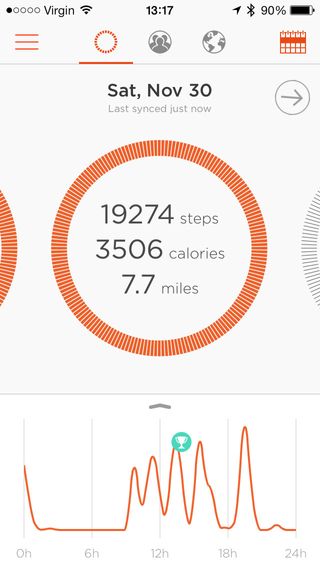Nike FuelBand SE vs Misfit Shine vs Jawbone Up24 vs Fitbit Flex
Which activity tracker is fittest for purpose?
Companion apps & syncing
Nike's app might be excellent (and upgraded for the FuelBand SE) but it's only available for the iPhone, so that rules it out for a hell of a lot of people.
It's a real shame because the Sessions feature is mightily impressive, with tweaked algorithms for activities ranging from yoga and weightlifting to boot camp and basketball. If only the band itself was waterproof.
The app also lets you add your own activities and add a self-rated intensity, thereby heavily skewing the results. We like the 'Go for it Jamie!' style messages on the wristband, though it might annoy some.
The Flex app's dashboard presents a simple list of stats for steps, miles, active minutes, calories burned, weight and sleep quality, wisely leaving its free-text entry add-ons – its food plan and glasses of water drunk – at the bottom.
A Goals section is where figures for those parameters can be set. It's a good at-a-glance app, though the graphs supplied for each are of little use.

The UP24 app is better. As well as great, chronological Facebook app-style presentation of your latest fitness stats, a Trends section can be tweaked to produce graphs on a plethora of parameters.
A Lifeline section attempts to meld everything together, but we had trouble understanding just what was going on here.
Get daily insight, inspiration and deals in your inbox
Get the hottest deals available in your inbox plus news, reviews, opinion, analysis and more from the TechRadar team.
The best part of Up24 is the chance to involve some (frankly more capable) apps into the dataset, including the likes of MapMyFitness, Sleepio, Strava, MyFitnessPal, RunKeeper and even If This The That (IFTTT), which takes UP24 into the wider world of the Internet of Things.
Probably the most basic app here is Shine (available on both iOS and Android), which gives a simple "Today" read-out that includes a 'last synced' time above a dial that's exactly the same size as Shine.
Around the edge is a orange line that represents how far you've walked as a percentage of your daily goal, which – rather confusingly – is measured in points, though also a useful message saying that you've got 'about 1 hour of walking left'.
A day is thus divided up into small boxes containing information like 'Kinda active, 15.32 minutes', which is nice and precise, but perhaps overdoing it.
The Shine and Up24 app have a Facebook dimension, and Up24 can tweet, too, so you can post inane messages like, 'Tarquin just achieved his daily goal of 2,187 steps', but we all know how annoying that can be for everyone else.
However, we do like the FuelBand and Flex's ability to hook up with other users and swap activity metrics. It gives a competitive edge that will be really useful to some for motivation. If a little rivalry won't get you motivated, what will?
The new Up24 app swaps the 3.5mm jack connection to Bluetooth 4.0, bringing it in line with the other three, all of which exchange data with a smartphone reasonably quickly.

Sleep management
Assign an activity in-app and all four record (very) rudimentary data on sleep, though only very basic metrics on periods of deep sleep and light sleep.
What you can do with that kind of information is very limited. Alhough knowing your total amount of time slept is handy, it's probably not enough.
If it's sleep tracking you're particularly interested in, you can forget about the Fuelband SE. While you can set sleep as an activity to be monitored, the actual tracking is very basic. That's probably because Nike doesn't believe that sleep can be properly measured properly outside of lab conditions.
The Flex manages a daily average, but if you're intensely interested in other sleep metrics, such as snoring volume (and even recorded highlights), head for SnoreLab or the brilliant MotionX 24/7.
The Up24 takes the prize here for its cute Smart Alarm, which aims to wake you up while you're in a light sleep period although though only within a preset limit (say, between 07:00 and 07:30).
It's something you appreciate when it works, though like apps such as Sleep Cycle that do the same thing, there's no guarantee that it always will.
Current page: Companion apps and syncing
Prev Page Introduction and design Next Page Value for money and verdictJamie is a freelance tech, travel and space journalist based in the UK. He’s been writing regularly for Techradar since it was launched in 2008 and also writes regularly for Forbes, The Telegraph, the South China Morning Post, Sky & Telescope and the Sky At Night magazine as well as other Future titles T3, Digital Camera World, All About Space and Space.com. He also edits two of his own websites, TravGear.com and WhenIsTheNextEclipse.com that reflect his obsession with travel gear and solar eclipse travel. He is the author of A Stargazing Program For Beginners (Springer, 2015),

